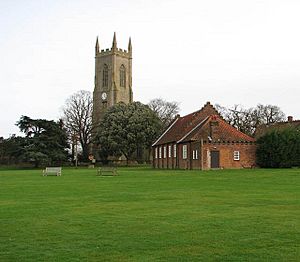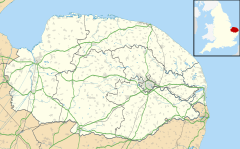Salle, Norfolk facts for kids
Quick facts for kids Salle |
|
|---|---|
 Salle church, behind the cricket ground |
|
| Area | 8.21 km2 (3.17 sq mi) |
| Population | 50 |
| • Density | 6/km2 (16/sq mi) |
| OS grid reference | TG109248 |
| Civil parish |
|
| District |
|
| Shire county | |
| Region | |
| Country | England |
| Sovereign state | United Kingdom |
| Post town | NORWICH |
| Postcode district | NR10 |
| Dialling code | 01603 |
| Police | Norfolk |
| Fire | Norfolk |
| Ambulance | East of England |
| EU Parliament | East of England |
| UK Parliament |
|
Salle (pronounced like 'Saul') is a small village in Norfolk, England. It's part of the Broadland area. The market town of Reepham is about 2.4 kilometers (1.5 miles) south of Salle.
The name "Salle" comes from "Sallow Wood." In the old Norfolk language, "sallow" means "willow." So, Salle means "willow wood." The village used to be called "Sall," but its name was officially changed to "Salle" in 1994.
Salle is a very small place. In 2001, only about 50 people lived there in 21 homes. The village covers an area of about 8.21 square kilometers (3.17 square miles). Salle is famous for its very large and beautiful church, which was built a long time ago in the Middle Ages.
Much of the village and the farms around it are owned by the Salle Park Estate.
Contents
Discovering St Peter and St Paul's Church
The church in Salle is called St Peter and St Paul's. It was built in the early 1400s and is a great example of a building style called "Perpendicular Gothic." This style is known for its tall, straight lines and big windows. The church is huge, especially for such a small village! This is because several rich families, including the famous Boleyn family, competed to help pay for its construction. Inside, you can find many old metal plaques called "brasses," some of which honor members of the Boleyn family.
The church still has some of its original stained glass windows from the Middle Ages. You can see them in the east window and in a window in the south part of the church. There's also a pulpit (a raised stand for speaking) from the 1400s. The font, which is a large basin used for baptisms, has a very tall and fancy wooden cover. This cover can be lifted up using a special crane.
The church's tower is 40 meters (130 feet) tall and is made of stone and flint. People have said it's one of the most beautiful and well-designed church towers from the late Middle Ages in all of East Anglia. Even though it's not a "collegiate church" (which means it wasn't connected to a college or group of priests), it has 26 special wooden seats called "misericords" from the 1400s. These are found on both sides of the choir area.
Community Life and Activities
Salle is home to the Reepham and Salle Cricket Club. Their cricket ground is right next to the church. There's also a large community building called the Lynton White Institute. This building is very old and important (it's a "grade II listed building"). It's used by the cricket club and other local groups for meetings and events.
You can also find a small brewery in the village called the All Day Brewing Company.
A Glimpse into Salle's Past
Salle has a long history. Two places in the parish, Sall and Stinton, were mentioned in the Domesday Book. This was a famous survey of England made in 1086. Stinton is now a "lost settlement," meaning the village no longer exists, but it was once near where Salle Place is today.
The area around Salle was historically part of a larger division called the "hundred of Eynesford."
In 1999, Salle won a special award: it was named Norfolk's Best Kept Village for villages with fewer than 500 people.
Exploring Salle's Surroundings
The village of Heydon is about 2.4 kilometers (1.5 miles) north of Salle. Another nearby parish is Wood Dalling. Because Salle has such a small population, it has a "parish meeting" instead of a larger "parish council" to manage local matters.
If you enjoy cycling, there's a special route called the Salle Cycle Loop. It's a circular trail that takes you along quiet lanes around the parish and its nearby areas.









